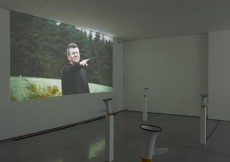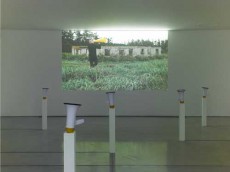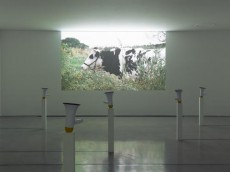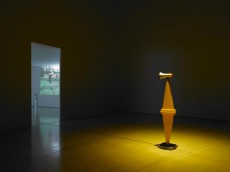
kaetemiru–Time For A Change
10:00am-6:00pm, October 22 — December 11, 2016/ admission free
ARIKAWA Shigeo
有川滋男
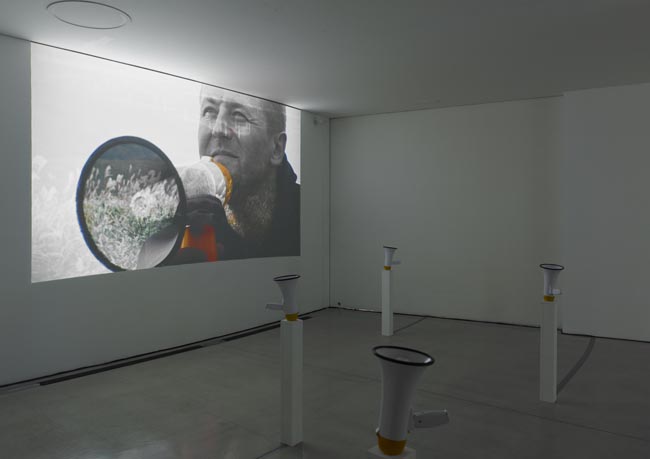
"(Re)(Re)interpretation"
Video projection on the wall(8minutes loop),
megaphone,color cones,2016
photo: YAMAMOTO Tadasu
Stories going round and round
ITO Satoko
In a dark room are colored cones and a megaphone, and the sound of wind is heard. In another room in the direction where the sound comes from, videos are projected on the left and right walls and nine megaphones are installed. The voices of plural people describing the images are heard from the megaphones, and a certain period of time is cut off while the place and the characters are kept unknown. In this work, nine viewers of an Arikawa-produced film, in which no word is spoken, created stories and the artist edited their voices reading the stories and made them into this installation.
By presenting hard-to-understand images using video and photography as media, Arikawa delays images to become stiff in one’s mind and makes works that expand the meaning of ‘seeing.’ In his video works produced during about five years before this program, he did not use any words. Since the act of ‘seeing’ is concomitant with ever-changing time and related memory and senses, it is necessary to ‘continue watching.’ Therefore, he avoids narrowing or limiting images by common recognition of words.[1] Using the opportunity of this residency production, however, he loosened the outline of what is visible by using the others’ words instead of his own, and that way, he attempted to delay stiffening of images. Stories made from the moving image include interpretation and creation. The finished work maintains objectivity in that all is not the artist’s creation. The artist has captured the subject through a camera filter, but here he seems to see the work again through viewers’ interpretations. In other words, one might say that ‘the work’ itself is presented through the agency of interpretations arising out of the work.
For Arikawa who explores ‘seeing,’ the theme of this exhibition kaetemiru—Time For A Change meant ‘kaete (change)’ and ‘miru (see).’ In his video this time, meanings of everyday things and the actions involved were changed, so, at first glance, the viewer could not understand what the characters in the video were doing. How does the viewer interpret the video image? In the setting of a field with rotating windmills, the scene continues to proceed matter-of-factly.
This hard-to-understand image is shaking our experience of ‘seeing.’ When the meaning that the viewer has taken for granted is stripped off, thrown out of our daily life, they try to find out what in the world it is. Observing with a fresh mind from scratch, they find out that colors and shapes that they see and sounds they hear turn into symbols, and letters that hardly form letters in the flowing images become clues to explain the meaning. What they need here are their consciousness trying to find a hidden background from visible shapes and unconscious non-visual perception. They manage to connect somehow their personal experiences in the past and add to them what is going on in their mind in order to find answers for each of them. For Arikawa, the condition of one’s seeing is not equal to the act of forming an image on the retina through the eye’s lens. Rather, it means what one chooses to see and how to see it, that is, how an image in the viewer’s mind is seen through his memory and perceptions such as tactile and hearing senses. The act of seeing is left further to individuals’ judgment, and there is the same number of different interpretations as that of viewers. Words are spun from incidents that they understand and ideas they think of, and ‘stories’ are told.
The same video on which the stories are based is projected on the walls facing with each other in the back room. The structure of having images separately on the left and right as seen from the entrance blurs the focus of the eye. Suddenly scenes from a different angle or of a different structure are projected to widen dimensions of the film, but the images of the same contents respond in concert with each other like a mirror and the images are iterated. Megaphones which also appear in the video function as speakers in this place. The voices telling each story of the nine individuals are heard. A megaphone is a tool to amplify the voice, and it converts sound and directs it outward. In this work, it is ‘a medium that changes’ something. Thinking of the process in which things are changed and interpreted through the medium, a megaphone can be regarded as a human being. Speakers are scattered on the entire floor so that one can listen to each different voice in a free position. Depending on the position of listening, it is difficult to understand what the words are saying or it could cause mishearing, but when fragments of the words are put together, another context and meaning are created. The ‘interpretation’ of the viewer creates ‘stories’ from the video without words at the production stage, and it repeats changing itself into another form in the installation completed as a piece of work. In addition, hearing others’ ‘stories’ in this space, the interpretation of the images which the viewer is actually looking at is changed.
In the last scene where the character turns to a megaphone, he expects us to hear such words that convey some meaning of the video, but despite such expectations, he starts humming a song. How to edit the voices in producing an installation is up to the artist’s ‘interpretation.’ During the production process, however, ‘stories’ were broken into ‘words,’ and further, only meanings were removed, and taken apart to something similar to ‘sounds.’ Words, while they provoke some images, no longer convey meanings but begin to be heard as sounds, and songs seem to be emitted from a megaphone as a mixture of words and sounds. Sounds are elements different from words, which have meanings, but in this work, they are arranged in parallel as playing the role of conveying images while floating in the space. The space is created by breaking up images, sounds and words, and in this work, the viewer is enveloped in the images. The viewer here links hearing and visual senses to reconstruct his interpretation and a story of the video. It works as a means to create a new interpretation.
By presenting before our eyes various ‘interpretations’ conceived from one video, the artist showed differences in what we are seeing and ambiguities in changing things that we are seeing including the agency of words. The act of ‘seeing’ is not fixing an image as temporary recognition. It shows us how ‘seeing’ incorporates the surroundings, not only visual, and continues to update those surroundings. Does the windmill rotating in the video represent an image that is continuously updated as well as the passage of time? ‘Nine’ of the nine stories seems to make us feel uneasy as we imagine if additional one would present something else. These stories refuse to be inflexible and continue to go round.
[1] According to an interview with ARIKAWA Shigeo, AC2, No. 18 (Aomori: Aomori Contemporary Art Centre, 2017)

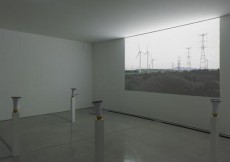
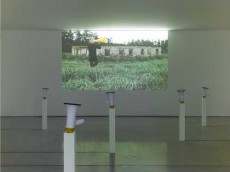

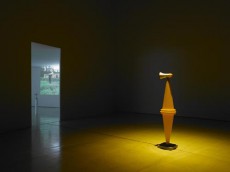
カエテミル
2016年10月22日(土)~12月11日(日)10:00~18:00 会期中無休・入場無料
有川滋男
ARIKAWA Shigeo
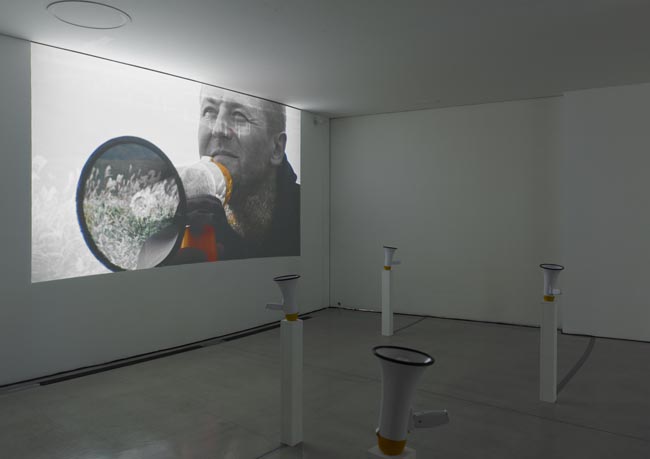
《(Re)(Re)interpretation》
壁面にビデオプロジェクション(8分間のループ)、拡声器、カラーコーン
2016年
撮影:山本糾
物語は回り続ける
伊藤聡子
暗い部屋の中にはカラーコーンとメガホンがあり、風の音が聞こえてくる。流れる音の方向にあるもう一つの部屋では、映像が左右の壁に映され、9つのメガホンが設置されている。メガホンからはその映像を描写する複数の者の声が聞こえ、場所も登場人物も不明なままある時間が切り取られる。この作品は、有川が制作した言葉のないひとつの映像に対して9人の鑑賞者が物語を制作、その物語を朗読する声を作家が編集し、最終的にインスタレーション作品として作り上げたものだ。
有川は映像や写真を媒体に、容易に認識しがたいイメージを提示することによって、イメージが認識の中で硬直するのを遅らせ、「見ること」の意味を拡張させる作品を制作している。このプログラム以前の5年ほどの間に制作された映像作品で、作家は言葉を用いることはなかった。「見る」行為は、刻々と移り変わる時間とそれに伴う記憶、感覚に付随するため「見続ける」行為が必須であるとして、言葉という共通認識によってイメージを狭めたり限定したりすることを回避するためだ (1)。しかし今回の滞在制作をきっかけに、作家による言葉ではなく他者の言葉を用いることによって、見えるものの輪郭を緩める試みがされている。ある映像から作られた物語は、映像に対する解釈と創造を含み、最終的な作品は作家の手ですべてが作りこまれない客観性をもつ。作家はカメラのフィルターを通して対象をとらえてきたが、この作品では鑑賞者、つまり作品の解釈を通して作品を再度とらえようとしているかに見える。あるいは作品から解釈が生まれるその作用を通して、「作品」そのものを提示しているともいえるだろう。
「見ること」を追求する有川にとっての今回の展覧会テーマ「カエテミル」は、「変えて」「見る」ことであった。制作された映像作品の中では、日常で使われる物やそれに伴う行為の意味が変えられ、一見登場人物が何をしているのかわからない映像が制作された。見る者は映像をどう捉えるのか。風車が回る草原を舞台に、場面は淡々と進んでいく。
認識しがたいこの映像は、「見る」という経験を揺さぶろうとする。見る者はそれまで当たり前だと思ってきたものの意味をはぎ取られて日常から放り出されると、それが一体何であるかを探し始める。真っ新な目で対象を一から観察してみると、目に映る色や形、聴こえる音が記号となり、流れる映像の中の文字にならない文字が読み解くための手がかりとなる。ここでは、目に映るものの形からさらに隠れた背景を見つけようとする意識と、無意識に視覚以外の知覚とを必要とする。それまでの個人の経験をどうにか繋ぎ合わせ、またその時点で頭の中で起っているものをかけ合わせてそれぞれの答えを見つけていく。有川にとって人がものを見ている状態とは、目のレンズを通して網膜に像を映し出すことではなく、そこから何を選びどう見るか、見る者の脳に浮かぶ像が、記憶、または触覚や聴覚など知覚を通して見えてくることだ。見る行為がより個人の判断に委ねられ、その鑑賞者の数だけ異なる解釈が生まれた。解釈した出来事、あるいは得た発想から言葉が紡がれて物語となった。
奥の部屋の向かい合った壁それぞれに物語のもととなるひとつの映像が映されているが、入口から見て左右にわける構成は、目の焦点をぼやけさせる。不意に異なる角度や構図の場面を映し出してひとつの映像の幅を広げながら、鏡のように呼応し、またはイメージを反復させている。映像の中にも登場するメガホンは、この場ではスピーカーの役割をし、9つそれぞれから一人一人の物語の音声が流される。メガホンは声を拡大するための機器であり、音を変換して外へ発するが、この作品では何かを「変化させる媒体」である。物事は媒体を通して変化される、解釈されるという過程から見れば、メガホンは人を示しているともいえるだろう。異なる音声を自由な位置で聞くことができるように、そのスピーカーは床全体に点在された。位置によって聞こえてくる言葉は理解しにくかったり、聞き間違えを起こさせたりするが、その言葉の断片の掛け合わせは、別の文脈と意味を作り出す。映像を鑑賞する者にとっての「解釈」は、制作段階において言葉のない映像から物語を作ることの他に、作品として完成したインスタレーションの中で別の形に変化しながら繰り返される。また、この空間で耳から得る他者の物語によって、鑑賞者自身の目で見る映像の解釈は変様されていく。
最後に登場人物がメガホンに向かう場面では、それまでの映像の何かしらの意味を表す言葉を発すると思わせるが、その期待をはずし、彼は鼻歌を歌い始める。インスタレーション制作における音声の編集はまた作家の「解釈」であるが、その過程で「物語」は「言葉」へ、さらに意味だけが取り除かれ、「音」に近いものへと解体されていった。言葉はイメージを浮かばせながらも、意味を成すためではなく音として聞こえ始め、歌は言葉と音を混在させたものとしてメガホンから発せられるかのようだ。音は意味を形成する言葉とは異なる要素だが、この作品ではイメージを伝える役割として並列し、空間を漂う。画と音と言葉に分解することで空間は作られ、この作品は見る者を映像の中に包み込む。ここでの鑑賞者は視聴感覚のそれぞれをつなぎ合わせ、映像の解釈、物語を再構築させる。新たな解釈を生む方法として機能しているのだ。
一つの映像から生まれる様々な解釈を目の前に提示することで、人が見るものの違い、言葉の作用を含んで見ているものが変化していく曖昧さを現した。「見ること」は一時的な認識としてイメージを固定させることではなく、視覚のみならず周囲を取り込み更新し続けていく状態であることを提示する。映像の中で回転する風車は、更新され続けるイメージと時間の経過を表すのだろうか。9つの物語の9という数字は、あと一つで何か見つかるのではないかともどかしい。これらの物語も固まることを拒み回り続ける。
(1) 2016年11月7日に行った有川滋男へのインタビューより(『AC2』18号、国際芸術センター青森、2017年)。
